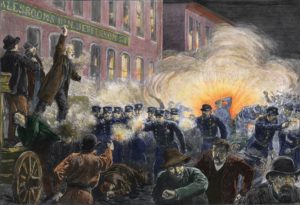 Labor Day falls on September 6th this year and started with the trade union and labor movements in the late 19th century. The holiday was proposed in the early 1880’s as a celebration of the achievements of American workers, and became a federal holiday in 1894. Before the labor movement demanded work condition improvements many people worked 12 hour days, 7 days a week just to maintain a modest living. Children as young as 6 worked in factories, mills and mines and work conditions were often unsafe.
Labor Day falls on September 6th this year and started with the trade union and labor movements in the late 19th century. The holiday was proposed in the early 1880’s as a celebration of the achievements of American workers, and became a federal holiday in 1894. Before the labor movement demanded work condition improvements many people worked 12 hour days, 7 days a week just to maintain a modest living. Children as young as 6 worked in factories, mills and mines and work conditions were often unsafe.
As early as 1835 coal heavers in Philadelphia organized a strike to demand work hour reductions to 10 hours a day. In 1864 in Chicago the 8 hour work day was the primary demand of the movement, and while legislation was passed, loopholes made it ineffective which caused strikes that shut down the city’s economy for a week. Over the next 20 years a few industries gained an 8 hour work day, but many more continued to advocate for changing work conditions.
On May 3rd, 1886, 6,000 workers confronted strikebreakers at the Chicago McCormick plant, and when the police arrived they fired on the crowd, killing four people and wounding many more. As a protest of the violence, a rally was held the next day at Haymarket Square, where a bomb went off. Many labor leaders were arrested, convicted and executed. 7 years later in 1893 the Illinois Governor set remaining jailed leaders free, and gave full pardons stating that the hanged men were victims of hysteria, packed juries and a biased judge.
Various industries slowly won 8 hour work days & improved conditions, such as the United Mine Workers in 1898, & the Building Trades Council in 1900. In 1914 Henry Ford made radical changes that rippled through the car industry by doubling pay to $5 a day ($129.55 today), and also cut shifts from 9 to 8 hours. Ford saw much higher productvitiy as well as profit margins doubling from $30 million to $60 million in two years, which caused many companies to follow their example. Ford also standardized the 5 day work week in 1926 by shutting down his factories all Saturday and Sunday.
The Fair Labor Standards Act of 1938 established in federal law many of the labor conditions we see today, including the 5 day work week, 8 hour work day with time and half overtime, and a right to minimum wage. It also importantly prohibits the employment of minors in child labor.
Today we celebrate Labor Day with picnics, barbecues and public gatherings, enjoying the long Labor Day weekend. It also signifies an end of summer, and the last chance for a summer weekend away for many people. However, it’s a day built from the achievements of American laborers, and our progress of labor standards.


